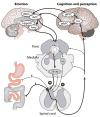Brain-gut axis: from basic understanding to treatment of IBS and related disorders
- PMID: 22027566
- PMCID: PMC3294167
- DOI: 10.1097/MPG.0b013e31823d34c3
Brain-gut axis: from basic understanding to treatment of IBS and related disorders
Abstract
The present review describes advances in understanding the mechanisms and provide an update of present and promising therapy directed at the gut or the brain in the treatment of irritable bowel syndrome (IBS). The diagnosis of IBS typically is based on identification of symptoms, such as the Rome III criteria for IBS in adults and children. The criteria are similar in children and adults. The focus of the present review is the bowel dysfunction associated with IBS.
Figures


References
-
- Longstreth GF, Thompson WG, Chey WD, et al. Functional bowel disorders. Gastroenterology. 2006;130:1480–91. - PubMed
-
- Saps M, Di Lorenzo C. Pharmacotherapy for functional gastrointestinal disorders in children. J Pediatr Gastroenterol Nutr. 2009;48(Suppl 2):S101–3. - PubMed
-
- Camilleri M. Mechanisms in IBS: something old, something new, something borrowed…. Neurogastroenterol Motil. 2005;17:311–6. - PubMed
-
- Ohman L, Simrén M. Pathogenesis of IBS: role of inflammation, immunity and neuroimmune interactions. Nat Rev Gastroenterol Hepatol. 2010;7:163–73. - PubMed
Publication types
MeSH terms
Substances
Grants and funding
LinkOut - more resources
Full Text Sources
Other Literature Sources

